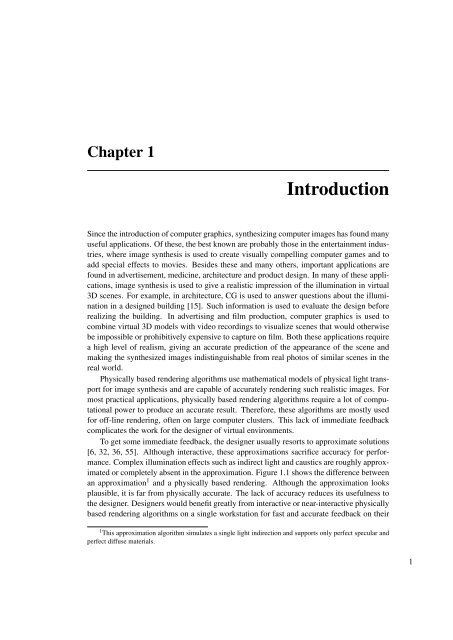Master Thesis - Computer Graphics and Visualization - TU Delft
Master Thesis - Computer Graphics and Visualization - TU Delft
Master Thesis - Computer Graphics and Visualization - TU Delft
You also want an ePaper? Increase the reach of your titles
YUMPU automatically turns print PDFs into web optimized ePapers that Google loves.
Chapter 1<br />
Introduction<br />
Since the introduction of computer graphics, synthesizing computer images has found many<br />
useful applications. Of these, the best known are probably those in the entertainment industries,<br />
where image synthesis is used to create visually compelling computer games <strong>and</strong> to<br />
add special effects to movies. Besides these <strong>and</strong> many others, important applications are<br />
found in advertisement, medicine, architecture <strong>and</strong> product design. In many of these applications,<br />
image synthesis is used to give a realistic impression of the illumination in virtual<br />
3D scenes. For example, in architecture, CG is used to answer questions about the illumination<br />
in a designed building [15]. Such information is used to evaluate the design before<br />
realizing the building. In advertising <strong>and</strong> film production, computer graphics is used to<br />
combine virtual 3D models with video recordings to visualize scenes that would otherwise<br />
be impossible or prohibitively expensive to capture on film. Both these applications require<br />
a high level of realism, giving an accurate prediction of the appearance of the scene <strong>and</strong><br />
making the synthesized images indistinguishable from real photos of similar scenes in the<br />
real world.<br />
Physically based rendering algorithms use mathematical models of physical light transport<br />
for image synthesis <strong>and</strong> are capable of accurately rendering such realistic images. For<br />
most practical applications, physically based rendering algorithms require a lot of computational<br />
power to produce an accurate result. Therefore, these algorithms are mostly used<br />
for off-line rendering, often on large computer clusters. This lack of immediate feedback<br />
complicates the work for the designer of virtual environments.<br />
To get some immediate feedback, the designer usually resorts to approximate solutions<br />
[6, 32, 36, 55]. Although interactive, these approximations sacrifice accuracy for performance.<br />
Complex illumination effects such as indirect light <strong>and</strong> caustics are roughly approximated<br />
or completely absent in the approximation. Figure 1.1 shows the difference between<br />
an approximation 1 <strong>and</strong> a physically based rendering. Although the approximation looks<br />
plausible, it is far from physically accurate. The lack of accuracy reduces its usefulness to<br />
the designer. Designers would benefit greatly from interactive or near-interactive physically<br />
based rendering algorithms on a single workstation for fast <strong>and</strong> accurate feedback on their<br />
1 This approximation algorithm simulates a single light indirection <strong>and</strong> supports only perfect specular <strong>and</strong><br />
perfect diffuse materials.<br />
1
















